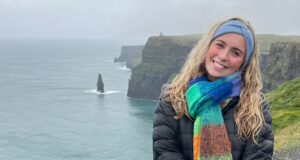By Michelle Karparis | Staff Writer
This past week, Salve Regina University hosted the 37th Annual Humanities and Technology Association Conference in the Pell Center of the Young Building. The theme of this year’s conference was ‘Morality and Creativity in a Technological Age’ and featured a panel made primarily of representatives from Salve Regina University, as well as representatives from other institutions.
“You might say that one of the biggest problems in the West has been in what way science, because of its ability to create all of this technology, in what way that technology rebounds back and changes our view of the world” said Dr. Troy Catterson, of Salve Regina University, in describing the purpose of the conference.
Among the representatives from Salve Regina were Dr. Sean O’Callaghan and Professor Michael Xiarhos, who presented in one of the final sessions on Saturday, November 5th. Both men are Religious and Theological Studies professors at Salve, and presented their theses on the impact of technology in today’s society from a theological perspective.
“Apocalypticism is alive and well,” said O’Callaghan to begin his lecture. His focus was on the evolution of apocalyptic thought and its recent development based on the ever increasing prevalence of technology in the modern world.
O’Callaghan described the progression from apocalyptic theories in the 1970s, which, being the Cold War era, envisioned an anti-Christ figure coming out of the Soviet Union, to the post-9/11 ideals that expected an anti-Christ to rise from Islam, and finally, to today, where technology poses what he describes as an “existential threat” to society.
The kinds of technology O’Callaghan referred to were GRIN technologies, “genetics, robotics, information technology, and nanotechnology.” In terms of an impending apocalypse, these technologies could mean computer enhancements, advanced weaponry, human/animal/alien hybridization, and “global totalitarian surveillance,” he explained.
“The common thread,” said O’Callaghan of apocalyptic theories, “is the interpretation of Genesis 6.” In this passage of the Bible, Nephilim is introduced as the human race corrupted by wickedness, that God ultimately wipes out in the terrible flood. He explained that today’s Nephilim is arising from genetic manipulation and technological advancements.
With so many different aspects of technology, no longer is apocalypticism directed at one common entity, ie: USSR, Islam, or ISIS, but it instead derives from “networks of leaders,” explained O’Callaghan, “all focusing on slightly different areas.” One thing apocalypticists do agree on however, is that a techno-apocalypse as a very real possibility in the future, marked by “human beings attempting to unseat God and create a superhuman race.”
“Technology is being used uncritically and is seen as the new ‘God’ of our age,” Catterson added in agreement in an interview after the lecture.
While O’Callaghan’s conversation revolved around the God-punishing aspect of technology’s effects on morality, Xiarhos’s approach portrayed an altered spiritual experience at the expense of technology.
The focus of Xiarhos’s lecture was on the spirituality of pilgrimage, specifically on the Camino de Santiago de Compostela. He provided the definition of ‘pilgrimage’ as a “focused, intentional travel to a ‘sacred’ location for the purpose of tactile, physical, embodied connection to a spiritual or metaphysical state.” That being said, a pilgrimage does not have to be a place of religious significance, like the Camino de Santiago, but it could be anywhere where people find sanctity in “sharing a sense of belonging,” such as the examples of Fenway Park or Ground Zero that Xiarhos provided.
The conflict that Xiarhos examined is whether or not the pilgrim experience is still possible in this technological age where people are “focused on a life spent consuming [information] rather than living from the inside out.”
Xiarhos has walked the Camino de Santiago de Compostela twice already and, through his experiences and observations, he has coined the phrase “the connected pilgrim.” What this means is that, with phone in hand, in pocket, or even buried in the bottom of a backpack, a pilgrim in this day in age is never actually alone.
“A pilgrim is never truly disconnected or solitary,” he explains; and, therefore, “they are never truly lost.” Even the most devout pilgrims on the Camino must fight for space and solitude when surrounded by so many other “connected pilgrims.”
Xiarhos described humans as “a communicative species” in which our connectedness is a way of “enhancing our natural tendency to communicate.” Essentially, the main form of communication for the current generation relies on the internet and social media. This generation is becoming so incapable of being disconnected that they are missing the actual experience going on beyond their five-inch cell phone screen.
While Xiarhos addressed the obvious threatening aspects technology poses to pilgrimage, the point of his lecture was not to completely reject the idea. He follows the ‘American Pilgrims on the Camino’ Facebook page, where one man posts brief video blogs every once in awhile to showcase his pilgrimage, but otherwise remains disconnected. Acting as a video journal, Xiarhos believes this could be a happy medium for technology on the Camino.
“Technology has the potential to enhance the experience,” said Xiarhos. Technology enables pilgrims to act as a “periscope” for those who are unable to experience it for themselves. This “virtual pilgrimage” thus extends the experience to loved ones kept away due to age or medical reasons.
Between the two speakers, this session of the conference displayed several different aspects of technology and its theological connotations. Catterson described the problem being addressed as “how do I find meaning and truth in an age that’s decided we don’t need it anymore.” O’Callahan and Xiarhos effectively elaborated on this question while stressing that the solution– how to actually find meaning and truth– is open to any individual’s interpretation of the impact of technology.
The Pell Center is located in the Young Building. Programs, like this one, run periodically throughout the year and are free for students to attend. For more information, go to pellcenter.org or contact pellcenter@salve.edu.













